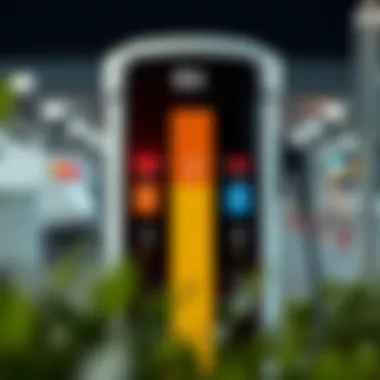Understanding Electric Vehicle Charging Durations


Intro
Electric vehicles (EVs) are increasingly becoming a fixture on our roads, often heralded as a solution to various transportation challenges, including environmental concerns and fuel prices. However, for those venturing into the world of EV ownership, one of the pressing issues is understanding charging durations. Prospective EV owners need to grasp how long it takes to charge their vehicles—factors like charging station types and battery capacity come into play here.
Understanding this topic is crucial, not just for convenience but also for efficiently planning daily routines, long trips, and even optimal charging station management. In this article, we aim to dissect charging times associated with electric vehicles, offering insights into how technology and consumer behavior interact in this space.
Investment Terminology
Definitions of Common Terms
When discussing EV charging durations, it's vital to be familiar with some fundamental terms:
- Level 1 Charging: Utilizing a standard 120V outlet, this method is the slowest, often adding about 4-5 miles of range per hour of charging.
- Level 2 Charging: A more rapid option often found at public stations or home systems, it operates on 240V and can typically add 10-60 miles of range per hour, depending on the vehicle and charger.
- DC Fast Charging: This is the speedy solution, able to charge vehicles up to 80% in around 30 minutes. It’s generally used for long-distance travel.
Industry Acronyms and Abbreviations
If you're diving into the electric vehicle realm, you’re bound to encounter various acronyms. Here are a few that might pop up:
- EV: Electric Vehicle
- PHEV: Plug-in Hybrid Electric Vehicle
- BEV: Battery Electric Vehicle
- kWh: Kilowatt-hour, a measure of energy that can power a device for one hour.
Familiarity with these terms lays a solid foundation for understanding the complexities surrounding EV charging and how it applies to potential usage scenarios.
Evaluating Charging Options
Understanding charging durations isn't just about the numbers; it’s equally about choices and strategies:
Types of Charging Stations
Different stations cater to various needs. Here’s a quick glance at what’s available:
- Home Chargers: Great for overnight charging, these stations often require installation and can vary in efficiency.
- Public Charging Stations: Often found in shopping centers or along highways, they can offer Level 2 or DC Fast Charging options.
- Workplace Chargers: Depending on employer offerings, these may be a convenient way for individuals to charge during the workday.
Battery Capacities
Battery capacity affects how long it will take to recharge. The larger the capacity, the longer it may take to fully charge. Typical capacities can range anywhere from 30 kWh to over 100 kWh for high-end models. This impacts both range and charging time, so consideration should be given based on individual needs.
Expert Insights and Advice
Strategic Charging Approaches
For the savvy EV owner, developing a strategy for charging is paramount. Here are some tips:
- Charge During Off-Peak Hours: Many utility companies offer cheaper rates during specific times, potentially saving money on energy costs.
- Utilize Apps: Various applications provide real-time data on nearby charging stations, helping to alleviate range anxiety and manage time effectively.
Risk Management Techniques
It's wise to prepare for unforeseen circumstances. For example, it’s sometimes beneficial to keep buffer time when planning trips that rely heavily on public charging.
Time management is as crucial in managing your charge as it is in managing your daily commute. Always have a plan B.
In summary, understanding and evaluating the charging durations for electric vehicles is a multifaceted topic that extends beyond basic knowledge. As we continue to explore the implications of EV technology and its infrastructure, having a comprehensive grasp of charging options will better equip potential EV owners to make informed decisions in their journey towards sustainable transportation.
For further reading, consider visiting resources like Wikipedia's Electric Vehicle page or checking out discussions on dedicated forums such as Reddit EV.
By understanding these ins and outs, you can be well on your way to navigating the electric future with confidence.
Prelims to Electric Vehicle Charging
Electric vehicles (EVs) are not just a trend; they are reshaping the way we think about transportation and energy consumption. With growing concerns about climate change and air pollution, understanding electric vehicle charging becomes increasingly important. As these vehicles become more common, potential owners need to grasp the intricacies of charging, not just to adapt to the technology but to make informed decisions.
The advent of electric vehicles brings multiple benefits. From reducing dependency on fossil fuels to lowering greenhouse gas emissions, the advantages are profound. However, one of the most pressing issues for users is charging duration. This is where the rubber meets the road, literally. Knowing how long it takes to charge a vehicle can significantly influence daily convenience, trip planning, and energy costs.
Understanding the Need for Electric Vehicles
The question arises: why are electric vehicles essential today? The automotive industry is undergoing a seismic shift towards electric mobility, driven by technological advancements and environmental imperatives. Traditionally, the combustion engine has powered our vehicles, but it has come at a hefty price in terms of pollution and resource depletion. EVs present a viable solution, offering cleaner alternatives without sacrificing performance.
Some factors pushing this transition include government incentives, consumer preferences leaning towards sustainable practices, and innovations in battery technology. For instance, manufacturers like Tesla have led the charge (no pun intended) by making electric cars not only accessible but desirable. In contrast to their gas-guzzling counterparts, EVs are often cheaper to operate and maintain, leading to long-term savings for owners.


This raises awareness around infrastructure, especially in terms of charging stations. The convenience of easily accessible charging is pivotal. Without widespread charging options, consumers might hesitate to take the leap into electric vehicle ownership. Furthermore, understanding how to engage with the charging ecosystem is crucial for a smooth transition.
Overview of Charging Mechanisms
Charging an EV isn't a one-size-fits-all scenario; there are various mechanisms that dictate how and when a vehicle receives power. The most notable types of charging mechanisms include Level One, Level Two, and DC Fast Charging. Each has its distinct characteristics and average charging times, impacting user experience.
- Level One Charging: This method utilizes standard household outlets. It's the slowest form, often taking hours to provide a full charge. Perfect for overnight plug-ins, it offers a straightforward solution for those with limited travel needs.
- Level Two Charging: More widely adopted, Level Two stations significantly cut down on charging times, often found in public spaces and homes with the proper setup. This level can provide a full charge in several hours, making it more convenient for daily use.
- DC Fast Charging: The speedster of the bunch, DC Fast Charging is designed for quick top-ups. Found primarily along highways, they can deliver enough energy for up to 80% charge in around 30 minutes, catering to long-distance EV travelers.
Understanding these charging mechanisms is vital for consumers when choosing an EV. It not only shapes their buying decisions but also informs their daily routines regarding travel and energy consumption.
In summary, electric vehicle charging is a foundational topic for anyone venturing into the EV market. By comprehending the various charging options and their respective times, potential owners can better navigate this new landscape, enhancing their overall experience while contributing to a more sustainable future.
"As the shift to electric vehicles accelerates, understanding charging dynamics will play a crucial role in shaping consumer habits and infrastructure developments."
For more information on the future of electric vehicle charging and developments in this sector, check out resources from the U.S. Department of Energy or Wikipedia's electric vehicle charging page.
By becoming informed on these aspects, consumers can expect a smoother and more efficient integration into the world of electric driving.
Types of Electric Vehicle Charging Stations
Understanding the different types of electric vehicle charging stations is essential for both current and prospective EV owners. This knowledge not only impacts the cost of ownership but also informs day-to-day charging habits and long-term planning. Selecting the appropriate charging station can mean the difference between a smooth daily routine and a frustrating experience.
Level One Charging
Characteristics
Level One charging is the most basic form of charging for electric vehicles. Using a standard household outlet, it operates on a voltage of 120 volts, making it incredibly accessible. The straightforward setup requires little more than plugging in an ordinary cord. This ease of use is a notable characteristic, especially for new EV owners.
However, this basic nature also leads to some limitations. Level One chargers are often slower than their more advanced counterparts, which can deter some users, especially those who rely heavily on their vehicles for daily commuting. Yet, for people who can charge overnight or have minimal driving needs, this can be a perfectly fitting option.
Average Charging Time
Charging times for Level One stations can stretch significantly. On average, it takes between 8 to 20 hours to fully charge an electric vehicle using this method, depending on the battery size. For example, if you drive a vehicle with a small battery, the time might lean closer to 8 hours. Conversely, larger batteries may push the charging time toward the higher end. This prolonged duration can pose challenges for those who might need to charge their vehicle more frequently throughout the day. Despite this, the convenience of simply using an existing power outlet is a substantial advantage in promoting widespread EV adoption.
Level Two Charging
Characteristics
Level Two charging employs a more robust power supply, usually around 240 volts. This type of charging station is often found in public spaces like shopping malls or workplaces, and it offers a nice blend of speed and accessibility. One major selling point is its ability to reduce charging time significantly—usually, a Level Two charger can deliver about 10 to 60 miles of range per hour.
This characteristic of fast charging can be crucial for users who are often on the go. However, installation can be costly, requiring specific electrical work to accommodate the new charging infrastructure.
Average Charging Time
The typical charging time with Level Two stations hovers around 4 to 8 hours for a full charge, which is a marked improvement over Level One. This aspect can be particularly appealing for those looking to charge during work hours or while engaged in other activities, as the time investment becomes more manageable. This fast turnaround improves the overall usability of electric vehicles in daily life, aligning more closely with traditional fueling methods.
Fast Charging
Characteristics
When it comes to urgency and speed, DC Fast Charging systems pull out all the stops. Operating on 400 volts or more, these stations can replenish an electric vehicle's battery rapidly. Dimensons and technology vary, but a general feature that stands out is the ability to charge up to 80% of the battery capacity in about 30 minutes.
This feature makes DC Fast Charging the preferred choice for long trips, similar to a gas station stop for conventional vehicles. That said, the availability of DC Fast Charging stations can be limited compared to Level One and Level Two options, largely due to the higher installation and operating costs.
Average Charging Time
Average charging time with DC Fast Charging is truly noteworthy; it can clock in under an hour for most vehicles. However, the high throughput does come with variability depending on the specific car model and battery size. For example, some vehicles may take longer if they have larger batteries, while others may maximize efficiency and get charged in roughly 20 minutes. Thus, it provides a compelling option for those needing to refuel quickly on longer trips, yet it is essential to plan charging stops when driving long distances as the infrastructure is not as widespread as others.
This knowledge of charging stations unveils a world of options for EV users. Each kind has its unique traits that can either suit a user's lifestyle or stand as a hurdle.
By disaggregating these options, potential buyers can make informed decisions, ensuring that their electric vehicle fits seamlessly into their daily lives, whether at home, at work, or on the road.
Factors Influencing Charging Times
Understanding the factors that influence charging times for electric vehicles (EVs) is crucial for both current and prospective owners. These elements play a significant role in determining how quickly an EV can be charged, which can impact a user’s daily routine and travel plans. From the size and capacity of the vehicle's battery to the power output of charging stations, each factor contributes to the overall efficiency and convenience of electric vehicle use.
When we look at charging times, it's not a one-size-fits-all scenario. Different vehicles, charging infrastructures, and external conditions can create a variety of charging experiences. Knowledge about these factors helps owners better plan their purchases and charging habits, ensuring they can squeeze more mileage from every charge.
Battery Size and Capacity


The battery size and capacity of an electric vehicle are fundamental to understanding how long it takes to charge. The larger the battery, the longer it usually takes to recharge. This makes sense: just as a bigger bucket takes longer to fill with water, a larger battery will require more time to reach full capacity.
- Typical Size Ranges: Most electric vehicle batteries fall within a size range of 20 kWh to 100 kWh. For instance, the Nissan Leaf generally has a battery capacity of about 40 kWh, while models like the Tesla Model S can contain batteries upwards of 100 kWh.
- Charging Time Correlation: A vehicle with a smaller battery, such as the Hyundai Kona Electric, not only can charge more quickly but also can often accommodate faster charging technologies, providing more flexibility in charging times.
Charging durations can also vary not just with size, but how much charge is needed at that moment. If you only need to charge a battery from 20% to 80%, it will take less time than charging from 0% to 100%.
Power Output of Charging Stations
The power output of charging stations significantly affects how quickly an EV can recharge. Different charging stations deliver power at varying rates, which ultimately dictates how long the charging duration will be.
- Charging Levels:
- Level 1 Charging: This typically delivers 1.4 kW to a maximum of 2.4 kW, making it ideal for overnight charging at home but relatively slow—expect around 5 miles of range per hour.
- Level 2 Charging: Power output here can range between 3.7 kW to 22 kW, making it more suitable for public charging stations. A station providing 7.2 kW can get most EVs back on the road in a few hours.
- DC Fast Charging: As the name suggests, these chargers can range from 25 kW to over 350 kW. They can provide about 80% charge to a vehicle in roughly 30 minutes, making them perfect for road trips.
Users should consider the availability of fast charging stations if daily driving involves considerable distances.
Temperature Impact on Charging
Temperature plays a largely underestimated role in charging times. Extreme cold or heat can significantly hinder the efficiency of an EV battery, thus affecting charging durations.
- Cold Weather: When temperatures drop, battery chemistry becomes less effective. Charging in frigid conditions can take considerably longer, sometimes doubling the time needed for a full charge.
- Hot Weather: Conversely, very high temperatures can also impede charging speed and may lead to overheating, which can trigger thermal management systems to slow down the charge rate to protect the battery.
Owners living in regions with severe weather conditions should account for potential delays in their everyday EV utilization.
Vehicle Technology and Software
Modern electric vehicles come equipped with sophisticated software and technological advancements that also influence charging times. Features such as battery management systems, power optimization algorithms, and charging schedules can alter the duration it takes to reach a full charge.
- Smart Charging Capabilities: Many contemporary EVs offer smart charging features. This means the vehicle can communicate with the charging station or even the grid to optimize when and how quickly it charges, based on peak usage hours and energy prices.
- Software Updates: Regular updates can improve the overall charging efficiency—ensuring the vehicle always operates with the latest improvements. Thus, it’s important for owners to keep their vehicle software up to date.
In some cases, end-users might be surprised at the difference a little tech can make. A vehicle's systems often fine-tune the available charging capacity based on multiple parameters, thus ensuring that the charge duration is as efficient as possible.
Bottom Line: All these factors combined illustrate that charging durations are not merely about plugging in a vehicle. Understanding these influencial aspects can empower owners and potential buyers with better insights into how their electric vehicles can integrate seamlessly into their lives—offering efficiency, convenience, and adaptability.
Practical Implications of Charging Times
The significance of charging times for electric vehicles stretches far beyond mere convenience; it encompasses a range of practical considerations that every potential EV owner must grapple with. As electric vehicles become a staple on our roads, understanding the implications of their charging durations is essential for optimizing daily routines, ensuring efficient travel, and maximizing overall vehicle utility. In the world of electric mobility, how quickly or slowly one can charge their car directly influences daily life, long-distance travels, and ability to access charging infrastructure effectively.
Daily Usage Considerations
When considering the daily routine of EV owners, charging time can be a pivotal factor. Many people charge their vehicles overnight at home. This involves planning around lifestyle needs. For instance, if a person has a long commute and relies on Level Two charging, they may find it beneficial to come home to a vehicle that is nearly fully charged by following a consistent charging schedule.
- Time Management: It’s vital to map out charging times alongside commutes and errands. Knowing how long it takes to recharge not only aids in effective time management but also minimizes the likelihood of running low on battery when you need it the most.
- Usage Patterns: People using their EV for short, in-town trips may not need extensive charging time if their commute is less than the battery range. More frequent top-ups at convenient points, rather than full overnight charges, can become the norm for some.
Then again, not every situation is predictable. Weather changes or unanticipated travel requirements can significantly affect battery consumption, making it necessary to have a flexible charging plan. In essence, understanding charging time alters the lens through which one views daily mobility.
Long-Distance Travel Planning
Planning a long journey in an electric vehicle requires a different level of foresight. Unlike gasoline vehicles, the availability of charging stations en route plays a crucial role in the equation. Here are key elements to consider:
- Charging Stops: Before hitting the road, it's wise to map out charging stations along the travel route. Knowing the Type of stations to expect — Level One or Level Two — can affect the length of breaks. Finding a DC fast charging station can dramatically cut down on downtime.
- Battery Management: Keeping an eye on battery capacity is essential during long trips. Drivers should account for changes in driving conditions, like steep grades or inclement weather, which may impact battery life. Performing calculations on how long it'll take to reach the next charging location is critical.
In the age of electric vehicles, being prepared means recognizing the nuances of charging times and planning effectively. This not only enhances the travel experience but also reassures drivers, allowing for smoother, stress-free journeys.
Charging Station Availability
The accessibility of charging stations can dictate the feasibility of owning an electric vehicle, especially for those residing in areas where this infrastructure is still developing. It is important to assess:
- Local Options: Are there enough charging stations nearby? It’s worth checking service providers like ChargePoint or Blink for station locations and charging speeds. Finding nearby stations with regular updates can be a game changer for any EV owner.
- Various Charging Types: Understanding which kinds of chargers are available locally, as well as their output, helps gauge how long a recharge will take. Having quicker access to DC fast chargers may become part of your travel routine, making trips more manageable.
- Community Engagement: Local EV groups or forums are often lined with valuable insights on reliable charging stations and sharing experiences about the local charging network. Platforms like Reddit or Facebook offer community-driven resources that provide real-time information on charging availability and station conditions.
Ultimately, an EV owner's understanding of charging station availability intertwines with their everyday life. As infrastructure evolves, so will the experience of driving electric vehicles, paving the way for a more seamless integration of these eco-friendly modes of transport into daily routines.
Comparative Analysis of Charging Times Among EV Models
Analyzing the charging durations across various electric vehicle (EV) models is not just a trivial task; it's crucial for potential buyers and current owners. This analysis helps consumers grasp how different technologies affect charging times, which in turn shapes their overall EV experience. Understanding charging durations can lead to better decision-making when selecting an EV, optimizing daily routines, and planning long-distance trips.
The heart of this analysis lies in comprehending how various factors—from battery capacity to charging station types—interact to influence an EV's charging duration. When consumers are aware of these nuances, it simply empowers them to make well-informed choices. Additionally, such comparative studies offer a broader view of the electric vehicle landscape, helping innovations gain traction by highlighting performance capabilities across the market.


Top EV Models and Their Charging Durations
Diving deeper into specific EV models reveals a spectrum of charging times influenced by a medley of factors. Each vehicle holds its unique characteristics that affect how long it takes to juice up fully. For instance, let's look at a few standout models:
- Tesla Model 3: Known for its efficiency, this model typically takes around 30 minutes for a DC Fast Charge to achieve about an 80% charge, thanks to a robust battery management system that optimizes charging speeds.
- Nissan Leaf: More modest in its charging capabilities, the Leaf can take anywhere from 4 to 7 hours to charge fully with a Level 2 charger. However, it's got a loyal following because of its affordability and decent range.
- Ford Mustang Mach-E: This sleek newcomer stands out with its rapid charging by taking about 38 minutes on average to reach 80% using a DC fast charger. This model effectively marries performance with charging efficiency.
- BMW i4: With a premium edge, the i4 leverages advanced battery tech for a competitive fast charging time of roughly 31 minutes for an 80% boost at supercharging stations.
These examples highlight just how diverse the charging durations can be based on model, powertrain technology, and battery size.
Cost Implications of Electric Vehicle Charging
Cost associated with charging electric vehicles certainly cannot be overlooked. Charging durations directly impact not just the time spent at charging stations but also the wallet. The electricity costs for charging can add up significantly, especially for those who rely heavily on public charging infrastructure. Here’s what potential EV owners should consider:
- Home Charging Costs: Charging at home is often cheaper and more convenient. Average residential rates can range from 10 to 20 cents per kilowatt-hour, leading to lower overall costs compared to public charging.
- Public Charging Fees: Charging stations can vary dramatically in pricing. While some are free, others may charge a fee based on time or energy consumed. Monthly subscription plans at certain networks might offer savings for frequent users.
- Impact on Driving Habits: Longer charging times may encourage drivers to shift their habits, minimizing unplanned trips or aiming for specific charging stations that offer faster options to save money along the way.
Understanding these implications is key for anyone considering investing in an EV. By examining charging times in depth, individuals can anticipate the potential expenses involved and better position themselves for a financially savvy EV ownership experience.
"By knowing the charging traits of different EV models, consumers can efficiently plan their journeys and make better economic decisions."
Future Trends in Electric Vehicle Charging
The landscape of electric vehicle (EV) charging is changing rapidly, driven by technological innovations, infrastructure developments, and evolving governmental policies. Understanding these future trends is essential for owners and potential buyers to navigate the electric vehicle market effectively. As consumers lean more towards sustainable transportation solutions, knowing the direction in which the charging infrastructure is headed becomes critical for informed decision-making.
Technological Advances in Charging
The ongoing evolution in charging technology is paving the way for a more efficient and user-friendly experience for electric vehicle owners. Companies are continuously investing in research to develop faster and smarter charging solutions. For instance, wireless charging technology—also known as inductive charging—offers the opportunity to charge vehicles without the traditional cable. This technology can potentially solve problems of space and accessibility at charging stations.
Additionally, ultra-fast charging stations are being developed to reduce the time it takes for EVs to recharge significantly. These stations can deliver enough power to charge an electric vehicle in a fraction of the time currently required. Such speedy charging options help to alleviate the common concern regarding range anxiety for EV users.
Another significant trend is the integration of smart technologies in charging stations. Features like smart load management allow users to optimize their charging times based on electricity rates and grid demand. This could lead to better energy savings and reduced operational costs for both consumers and utilities.
"Emerging technology is not just about charging faster; it's about reshaping our approach to energy use and management, providing potential savings while maximizing the utility's efficiency."
Infrastructure Development Challenges
Despite these advancements, the journey towards a fully-fledged charging infrastructure is not without its hurdles. Building a network dense enough to accommodate the rising number of electric vehicles poses multiple challenges. Urban areas may lack space for installing stations, while rural regions may find it hard to justify the cost of developing new sites.
Moreover, there is the question of accessibility. Not all EV owners have the luxury of plugging their vehicles in at home or work. Public charging stations need to be distributed evenly to cater to all users, which requires careful planning and investment.
Financial challenges cannot be ignored either. The cost of establishing new charging stations and maintaining existing ones often falls onto private businesses, which may hesitate to invest without assured profits. Finding a balance between public and private funding is vital to facilitate an extensive charging infrastructure.
Government Policies Supporting EV Infrastructure
Governments across the globe play a pivotal role in ushering in the electric vehicle revolution. Incentives such as tax rebates for EV owners, funds for developing charging infrastructure, and grants for research into technology improvement showcase their commitment towards sustainable transportation.
Policies that regulate the installation of charging stations in new developments provide the required momentum. For instance, mandates that require businesses and residential complexes to include EV charging capabilities can encourage both private and public sectors to invest in infrastructure growth.
Furthermore, international bodies are also stepping in—encouraging collaboration between countries in sharing best practices for infrastructure development. By unified actions, governments can ensure that charging facilities are not only plentiful but also standardized, enhancing user experience and charging reliability across different regions.
For further information on electric vehicles and their infrastructure, you might find these resources helpful:
- U.S. Department of Energy – Electric Vehicles
- Wikipedia – Electric Vehicle Charging
- Reddit – EV Charging Discussion
Closure
The conclusion of this article serves as a significant capstone that brings into focus the broader implications of charging durations for electric vehicles. Understanding this topic is essential for both potential and current EV owners as it shapes their everyday experiences and future decisions regarding electric vehicle usage.
Electric vehicles, while growing in popularity, come with their own unique set of challenges—charging times being perhaps the most prominent. For many users, the nuances of charging stations, ranging from level one to DC fast charging, can create confusion in their daily routines. Therefore, grasping the essentials of charging durations not solely informs users about the mechanics of their vehicles, it also directly impacts their efficiency and convenience.
Key Elements of the Finale:
- Knowledge is Power: The intricacies of charging times are crucial for making informed decisions regarding the ownership of an EV. A lack of understanding could lead to prolonged waiting periods or ill-timed charging sessions, causing undue stress or inconvenience.
- Financial Considerations: Awareness of charging durations can also influence economic decisions. Users who know their vehicle's charging patterns can better calculate costs associated with energy bills and identify optimal times to recharge for both convenience and economic advantage.
- Long-Term Planning: The rise of electric vehicles isn’t a fleeting trend; it’s here to stay. With advancements in technology and increasing infrastructure, staying abreast of changing charging durations means being prepared for the future of transportation.
In summation, understanding the charging durations for electric vehicles is not just about knowing how long it takes to power up a car. It's about integrating this knowledge into a broader understanding of how it affects routines, budgeting, and future planning for EV enthusiasts.
Summary of Key Findings
A thorough evaluation reveals several significant insights into the realm of electric vehicle charging:
- Types of Charging Stations: Different charging levels cater to various needs, ranging from home charging at level one to rapid charges at DC fast stations. Each has its characteristics and timeframes that users must navigate.
- Influencing Factors: Battery size, power outputs, and external conditions such as temperature play vital roles in determining charging durations. Understanding these variables equips users with tools to optimize their charging habits.
- Practical Implications: Daily usage patterns vary wildly among users, affecting their charging strategy. Factors like vehicle technology, availability of charging stations, and travel plans significantly shape how one interacts with their vehicle’s charging needs.
Future Considerations for EV Owners
Looking ahead, EV owners need to keep several factors in mind as the landscape of electric vehicles and their charging continues to evolve:
- Technological Innovations: Future advancements in battery technology could lead to shorter charging times, increasing convenience.
- Sustainable Practices: As environmental concerns heighten along with EV ownership, utilizing renewable energy sources for charging can play a pivotal role in the sustainability narrative.
- Infrastructure Growth: With more charging stations being developed, control over charging times could improve, making it crucial to stay informed about infrastructure changes in one’s locality.
- Government Policies: Legislative support for EV infrastructure, including incentives and regulations, can change the dynamics of how and where EV owners charge their vehicles, impacting their overall ownership experience.







